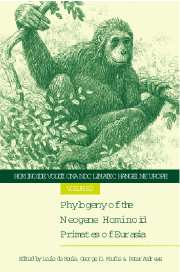 Hominoid Evolution and Climatic Change in Europe
Hominoid Evolution and Climatic Change in Europe Book contents
- Frontmatter
- Contents
- List of Contributors
- Acknowledgements: The European Science Foundation
- PART I: Chronology and environment
- PART II: Methods and phylogeny
- PART III Miocone hominoids: function and phylogeny
- 8 Eurasian hominoid evolution in the light of recent Dryopithecus findings
- 9 Functional morphology of Ankarapithecus meteai
- 10 African and Eurasian Miocene hominoids and the origins of the Hominidae
- 11 Phylogenetic relationships of Ouranopithecus macedoniensis (Mammalia, Primates, Hominoidea, Hominidae) of the late Miocene deposits of Central Macedonia (Greece)
- 12 Phylogeny and sexually dimorphic characters: Canine reduction in Ouranopithecus
- 13 Heterochrony and the cranial anatomy of Oreopithecus: some cladistic fallacies and the significance of developmental constraints in phylogenetic analysis
- 14 The late Miocene hominoid from Georgia
- 15 Forelimb function, bone curvature and phylogeny of Sivapithecus
- 16 Sivapithecus and hominoid evolution: some brief comments
- Index
15 - Forelimb function, bone curvature and phylogeny of Sivapithecus
from PART III - Miocone hominoids: function and phylogeny
Published online by Cambridge University Press: 06 January 2010
- Frontmatter
- Contents
- List of Contributors
- Acknowledgements: The European Science Foundation
- PART I: Chronology and environment
- PART II: Methods and phylogeny
- PART III Miocone hominoids: function and phylogeny
- 8 Eurasian hominoid evolution in the light of recent Dryopithecus findings
- 9 Functional morphology of Ankarapithecus meteai
- 10 African and Eurasian Miocene hominoids and the origins of the Hominidae
- 11 Phylogenetic relationships of Ouranopithecus macedoniensis (Mammalia, Primates, Hominoidea, Hominidae) of the late Miocene deposits of Central Macedonia (Greece)
- 12 Phylogeny and sexually dimorphic characters: Canine reduction in Ouranopithecus
- 13 Heterochrony and the cranial anatomy of Oreopithecus: some cladistic fallacies and the significance of developmental constraints in phylogenetic analysis
- 14 The late Miocene hominoid from Georgia
- 15 Forelimb function, bone curvature and phylogeny of Sivapithecus
- 16 Sivapithecus and hominoid evolution: some brief comments
- Index
Summary
Introduction
Rarely have functional inferences been as significant to phylogenetic reconstructions as in the case of Sivapithecus. Although fossils now considered to be Sivapithecus were once thought to be hominid ancestors, the discovery of a facial skeleton (GSP 15000) attributed to Sivapithecus provided strong evidence of an exclusive relationship with Pongo because of a suite of shared, derived traits (Pilbeam, 1982; Ward & Kimbel, 1983; Ward, 1997b). However, the discovery of Sivapithecus postcranial remains, notably two humeral shafts, cast doubt on these relationships (Pilbeam et al., 1990). The anteriorly-convex and medially-concave humeral shaft morphology of these fossils revealed that the orang-utan-like face of Sivapithecus is combined with a pronograde quadrupedal skeletal design unlike that of extant apes. Pilbeam et al. (1990) posited that the fossil evidence is consistent with two phylogenetic scenarios, each requiring a considerable amount of homoplasy. First, Pongo and Sivapithecus may be sister taxa, in which case many postcranial features shared among extant hominoids must have evolved in parallel (Figure 15.1A). Secondly, Pongo and Sivapithecus may not form a clade, in which case the similarities in the face and palate are convergently derived or primitive for great apes (Figure 15.1B). A scenario in which the palatal and facial similarities are primitive for great apes requires subsequent reversals in extant African apes and humans. A third possibility, that Pongo and Sivapithecus are related and that the supposed primitive post-cranial features are in fact reversals from a more modern ape-like condition, was considered by Pilbeam et al. (1990) to be unlikely in the light of postcranial similarities between Sivapithecus and other fossil hominoids such as Proconsul and Equatorius (formerly Kenyapithecus africanus; see Ward et al., 1999).
- Type
- Chapter
- Information
- Hominoid Evolution and Climatic Change in EuropePhylogeny of the Neogene Hominoid Primates of Eurasia, pp. 326 - 348Publisher: Cambridge University PressPrint publication year: 2001
- 21
- Cited by


